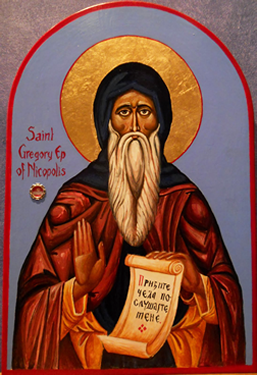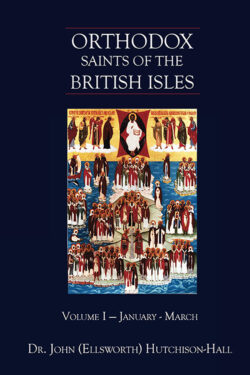
Orthodox Saints of the Pre-Schism
See of Rome
29th March (NS) — 16th March (OS) 2024
ABBAN, (Fifth Century), a nephew of St. Ibar (23rd April), and contemporary of St. Patrick (17th March), St. Abban founded Kill-Abban Abbey in Leinster. No further information on this saint is extant.
AGAPITUS (AGAPETUS), a third or fourth century Bishop of Ravenna. There seem to have been two Bishops of Ravenna called Agapitus. One in the third century and the other in the fourth. Over time their lives have become conflated. It seems that the third century Agapitus is St. Agapitus, and the fourth century one has never been venerated as a saint. Of course, the paucity of reliable records makes it impossible to state with any certainty, which is which.
DENTLIN (DENTELIN, DENAIN), (Seventh Century), the son of St. Vincent Madelgarus (20th September) and St. Waldetrudis (9th April), and brother of SS. Landry (17th April), Adeltrudis (25th February), and Madalberta (7th September). Though only seven years old when he reposed, he has always been venerated as a saint with the rest of his family.
EUSEBIA, the eldest daughter of SS. Adalbald (2nd February) and Rictrudis (12th May); great-granddaughter of St. Gertrude the Elder (6th December); sister of SS. Maurontius (9th January), Clotsindis (30th June), and Adalsindis (25th December). When St. Eusebia was still quite young her father was murdered and her mother sent her to the Hamage Abbey (Abbaye d'Hamage), where her great-grandmother, St. Gertrude the Elder (6th December), was the founding abbess. when St. Gertrude reposed St. Eusebia was elected to succeed her, even though she was only twelve years of age. St. Rictrudis, realising that St. Eusebia did not have the experience to be an abbess, took over Hamage, merging it into her own Abbey of Marchiennes (later known as the Abbey of SS. Rictrude and Peter of Marchiennes / Abbaye Sainte-Rictrude et Saint-Pierre de Marchiennes). All the nuns were moved from Hamage to Marchiennes, resulting in a fair bit of dissent amongst the nuns from Hamage. In time St. Rictrudis blessed Hamage nuns return to Hamage with St. Eusebia as Abbess. The time at Marchiennes served St. Eusebia well, as she had grown in wisdom and spirituality. St. Eusebia served as the second Abbess of Hamage until her repose in 680.
FINIAN, a disciple of St. Columba of Iona (9th June), he is said to have been Abbot of Swords just north of Dublin. However, as is the case with many of his contemporaries, ascertaining the truth within the various and tangled traditions of his Life is impossible.
GREGORY MAKAR, an Armenian monk who was elected Bishop of Nicopolis in Armenia. Later he lived as a hermit in Pithiviers near Orleans, reposing circa 1000. St. Gregory Makar is credited with introducing gingerbread to Europe.
HERIBERT, son of Hugo, Duke of Worms, St. Heribert was educated at the Abbey of St. Gorgonius of Gorze (abbaye Saint-Gorgon de Gorze — Gorze Abbey). In 994, having completed his studies, St. Heribert was ordained to the priesthood, and made Provost of St. Peter’s Cathedral in Worms. In 999, St. Heribert was consecrated fourteenth Archbishop of Cologne. As Archbishop, St. Heribert founded a monastery and church at Deutz on the outskirts of Cologne. St. Heribert was honoured as a saint during his lifetime, a wonderworker his prayers ended a drought. St. Heribert reposed in 1021 and his relics were enshrined at the monastery he founded.
HILARY, TATIAN, FELIX, LARGUS, and DIONYSIUS, Hilary, Bishop of Aquileia, Tatian, his deacon, and three laymen, beheaded during the persecutions under Emperor Numerian (r. 283–284) circa 284.
MEGINGAUD (MENGOLD, MEGINGOZ), a monk and eventually Abbot at Fritzlar in present-day Hesse in Germany. In 754, St. Megingaud, was consecrated second Bishop of Würzburg. St. Megingaud resigned his See in 769 and retired to Neustadt am Main Abbey (Kloster Neustadt am Main). There he spent the next fourteen years in prayer. St. Megingaud reposed at Newstadt in 783.
Get your copy of Orthodox Saints of the British Isles today.
Available at Amazon or your favourite e-bookstore.
ARMOGASTES and COMPANIONS, members of the royal court, and orthodox Christians, who suffered in North Africa at the hand of the Arian Gaiseric, King of the Vandals (r. 428–477). After being tortured they were enslaved and initially sent to work the mines. Genseric wanted to behead the saints, but he was advised by a cleric at court not to, lest they be venerated as martyrs. They were then sent to live out the rest of their lives as cowherds circa 460.
EUSTACE (EUSTASIUS), a monk and spiritual child of St. Columbanus (23rd November) at the Abbey of SS. Peter and Paul of Luxeuil, and his successor as Abbot of Luxeuil. During St. Eustace’s abbotship, there were over six hundred monks at the Abbey, and a seminary that trained many future bishops and saints. St. Eustace spent many hours in prayer daily, and was also a wonderworker, restoring sight to St. Sadalberga (22nd September), after she became blind. St. Eustace reposed in 625.
FIRMINUS, a sixth century Bishop of Viviers in southern Gaul. He is said to have only served for a few months, or even weeks, before resigning in favour of his son.
GWLADUS (GLADYS), (Fifth Century), a daughter of the famous King St. Brychan of Brycheiniog (6th June). St. Gwladus was the wife of St. Gwynllyw (vide infra), and mother of St. Cadog (24th January). There are no further reliable details of her life extant.
GWYNLLYW (WOOLLOS), Gwynllyw Milwr or Gwynllyw Farfog, known in English as Woollos the Warrior or Woollos the Bearded (Latin: Gundleus, Gundleius or Gwenleue), was the King of Glywysing in South Wales and the legendary founder and patron saint of the City of Newport. According to Lives written some six hundred years after his repose, St. Gwynllyw Milwr was a feared warlord, raider, and associate of King Arthur. He later found religion, quite possibly under the influence of his son, St. Cadog (24th January) and wife St. Gwladus (vide supra), and became a hermit, at the location where St. Woollos Cathedral in Newport was later built. St. Gwynllyw reposed circa 500.
LASAR (LASSAR, LASSERA), (Sixth Century), an Irish monastic St. Lasar was a niece of St. Fortchern (17th February). The noted hagiographer and historian John Colgan O.F.M. (†c. 1657) provides limited details of her life, of uncertain reliability, as do the Bollandists , in the Acta Sanctorum. From these it is known that she spent her early years in the care of SS. Finian (7th April) and Kieran (9th September) at Clonard, before entering an unknown monastery.
SECUNDUS, a patrician and subaltern in the Imperial Roman Army, St. Secundus was baptised in Milan, and arranged the illegal Christian burial of St. Marcian (6th March), after the saint had been martyred. St. Secundus then fled to hide with his family in Asti in Piedmont, where he was arrested, tortured, and beheaded circa 119.
Prior to the Schism the Patriarchate of Rome was Orthodox, and fully in communion with the Orthodox Church. As Saint John of Shanghai and San Francisco +1966 said “The West was Orthodox for a thousand years, and her venerable Liturgy is far older than any of her heresies”.
Details of British Saints excerpted from Orthodox Saints of the British Isles.
Details of continental saints from these sources.
In many cases there are several spelling versions of the names of saints from the British Isles. I use the Oxford Dictionary of National Biography version as the primary version with the more prevalent version in parenthesis e.g. Ceadda (Chad) of Lichfield.


